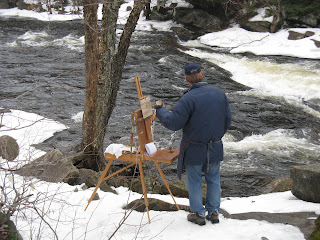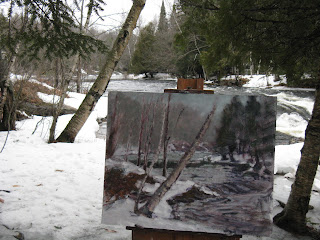My brother the Guitar maker has added a second plein air paint box to his offerings. The box is similar to the travel mate with the addition of a front opening drawer to hold paint or other items of choice. The drawer is mounted with stops to keep it in position as you angle the box to your preferred position.
One Drawer Mounted, Travel Mate in Background
The new model offers the same rugged construction, ease of operation, flexibility of design, adjustability etc as the Travel Mate. Its advantage is a single location for your supplies. Of course the added material adds a bit of weight.
Goodies in the Front Drawer
The front drawer has a removable lid that can act as a palette extension. I like the front mount because it keeps me from getting close to the painting surface where I might be tempted to niggle and pick instead of painting. I use this approach with my studio easel.
With Panel and Side Wing
Here the box is shown with a panel mounted and an optional side wing. A wide variety of panel sizes can be accommodated. The side wing can be used on either side. The panel can be raised easily to your line of site minimizing your eye travel. Very important when you are painting what you see.
Should you be interested in more information, or in acquiring either model of box, email me at gperdue1@cogeco.ca and I will put you in touch with my brother.



































.JPG)





.JPG)
.JPG)
.JPG)








